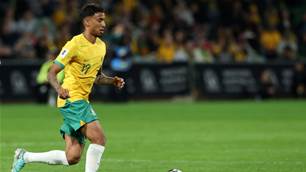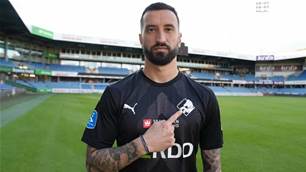FFA technical director Han Berger explains the progress of our National Curriculum.
AUSTRALIAN youth football used to be about results and strength. FFA technical director Han Berger explains how every level is now focused on technically gifted match-winners...
Tough, hard-working, dedicated, strong and determined to win. That could be the description of an Aussie footballer from any era. But success in modern football does not dictate to such a breed of player.
The top level club and country landscape is dominated by technically gifted, and often diminutive, ball-playing creators. In the third part of our youth development series, we speak with FFA technical director Han Berger about his blueprint for producing technically gifted players in Australia. There has been some vacillating interpretations from fans and the media of Berger’s plans, so here we set the record straight by presenting an unfettered account of his plans.
Berger oversees coach education and the implementation of a training and playing system for the country’s most talented youth footballers. The former Eredivisie, J.League and Netherlands U/23 and U/21 coach has also marshalled the development of the Dutch national youth system, and has an even taller task ahead of him in Australia now.
After his November 2008 appointment, taking over from countryman Rob Baan, one of Berger’s primary tasks was the development of the National Football Curriculum (NFC). The Curriculum was launched in May 2009 and has the long-term aim of improving the skill level, quality and performance of Australia’s top players and teams.
“Within five to ten years, there should be a clear difference with the current situation,” says Berger. “Regarding the coaching and training of young players, a mentality shift is needed and that’s not an easy thing to achieve. In Australia, from the earliest childhood, the focus lies on getting results – winning at all cost. That is the mentality of Australians and it is a positive characteristic. However, the consequence for youth football is that selections are made on physical characteristics. The biggest, strongest and fastest children are being identified, rather than looking for the most talented ones. This is reflected in the general style of play at youth level: launching the ball from the back and the physically strongest players making the difference to the result. It’s “fight-ball” rather than football.”
Berger explains that while the purpose of football is obviously about winning the game, at a younger age it is important to teach kids the proper game skills, which will give them a better chance to be successful when they reach senior level. He stresses that at top level, fitness and strength are not the decisive factors, citing the 2010 World Cup where the likes of Xavi, Özil, Iniesta, and Sneijder dominated. “In Australia, we need to produce better players instead of fitter players – that is the essence of the Curriculum. There has been too much focus in the past on developing athletes.”
Berger insists he is focused on building a football culture in Australia where the game is played all year round and there are plenty of opportunities for kids of every age to enjoy the game and develop themselves.
“The long-term objective of the Curriculum is to produce match-winning players,” says Berger. “Top level football today is about technical and tactical qualities. The top teams play a possession-based style of football and they all have a number of match-winning players who are able to decide games based on their outstanding technical qualities.
Fitness is not the decisive factor at the top, special players are. Fulfilling this aim is not going to be easy and it is not going to happen overnight. The Curriculum’s Building Blocks methodology is the framework that provides the practical guidelines for coaches working at all levels of youth development.” In other words: it explains what should be taught to players at various ages, from five all the way up to 20.
It starts when kids are between five and roughly 10 years-old with the ‘Discovery Phase’, where youngsters should simply “play football in a natural way”. “At this stage, there is little need for ‘coaching’,” says Berger. “Mimicking the ancient situation of street football is the best you can do. Many coaches make the mistake to structure training too much at this age. Just let these young kids play and discover what they can and cannot do with a ball. The game is the best teacher at this age, that’s why Brazilian and African players are technically so good: not because of their ‘system’ but because they’ve developed naturally.”
The next step between 10 and 13 years-old, is the ‘Skill Acquisition Phase’, where training becomes more structured and the emphasis is placed on developing a solid technical foundation. “This age is, in terms of physical and mental development of a child, the ideal period to develop motor skills,” explains Berger.
Between 13-16 years of age, the period of growth spurts and puberty, the emphasis is placed on learning to play as a team. FFA call this phase the ‘Game-training Phase’. Berger explains that the players are now mentally able to work together and to understand and execute both individual and team tasks. It is important that a coach who is working with players of this age is able to design ‘game-related’ training sessions in order to teach the players how to better solve the ‘football problems’ they encounter during the games.
The fourth phase, starts from about 16 onwards. The players have completed the growth spurt and are ready for competitive football. This ‘Performance Phase’ focuses on performing (and winning!) as a team in a competitive environment. “This is also the moment where fitness training is getting relevant, at least if it’s done in a football specific way,” says Berger. “In youth football in Australia a lot of valuable training time is wasted on non football-specific, irrelevant so-called strength and conditioning training that sometimes even is detrimental for children’s health.”
Throughout each of these phases the game format gradually changes: “up to seven years-old the game is played four-versus-four, the eight and nine-year-olds play seven-versus-seven and the 10 and 11-year-olds play nine-versus-nine – obviously on an increasingly large playing field,” says Berger. “From there we switch to 11-versus-11 on the big field.
These so-called Small Sided Game formats are still not generally accepted everywhere in Australia, which I find amazing because everywhere else in the world of football people understand the rationale of this. Football is a complicated game where players have to constantly make decisions. The bigger the numbers and distances, the more complicated the game. With smaller numbers and pitches the game is less complicated, kids get more touches on the ball and therefore the game is more fun. If you want to teach a child how to swim, you also would not throw it straight into the two-metre deep Olympic pool, would you?”
As kids play this brand of Small Sided Football, the emphasis again should not be focused on results. While Berger acknowledges that the purpose of football is to win games, youth football should not be about winning at all costs. There is a recommendation not to keep rankings and play for championships until the age of 12 at the very earliest, but Berger concedes this is a “very sensitive matter”.
While the theory and structure is established, the implementation in a vast and diverse Australia is the core of Berger’s challenge. “I’m sorry to say it, but the general level of youth coaching in Australia is still very poor. A lot of valuable training time is wasted on irrelevant, non-football content,” says Berger. “Training pitches are filled with hurdles and ladders and so-called youth coaches run the kids around the pitch. This disguises their inability to teach kids the proper game skills and they get away with it because the majority of parents lack football knowledge. Because of this FFA has created a development pathway for the most talented 10 to 18-years-old players. Within this pathway we apply the principles of the National Curriculum and the Building Blocks methodology.”
The ‘Discovery Phase’ – the first Building Block for kids between five and roughly 10 years-old – is all about grassroots and small-sided football. “There are no national programs for this age and neither should there be,” explains Berger. “Kids this age should just play and enjoy the game. We are aware that we need to improve the level of grassroots coaching which we try to do through our free-of-charge community coaching courses and state coaching conferences. We will also introduce community skill acquisition coaching courses in the near future too.”
Continues on next page...
Related Articles

Socceroos midfielder embraces move to England

Cardiff City snap up sought-after Socceroos starlet













